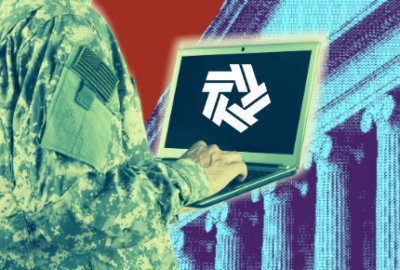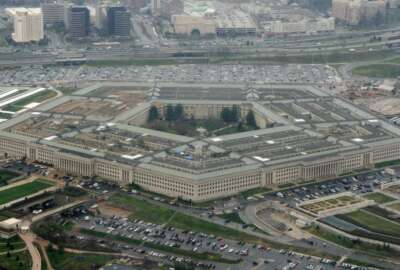Hubbard Radio Washington DC, LLC. All rights reserved. This website is not intended for users located within the European Economic Area.
Navy says two programs show the case for ‘colorless’ IT spending
The Department of the Navy says it’s seen some big successes with a pilot program that lets them use a single color of money for software, and wants Congress ...
The Navy says it’s seen huge successes in a pilot project that aims to change the decades-old, hardware-centric budgeting model Congress and the Pentagon use to plan and execute DoD’s spending into one that actually makes sense for modern information technology. But proving to lawmakers that it’s a good idea, so far, has been challenging.
The basic idea is to set aside the traditional colors of money DoD uses for various phases of the development of a big weapons platform — R&D, procurement and sustainment — and instead, let IT program managers draw from one bucket of money throughout a program’s lifecycle as they continuously improve what they’re offering.
The Software and Digital Technology Pilot Program, sometimes known as Budget Activity 8 (BA-8), has only been around for three years, but the ability to use a single color of money is a dramatic departure from the way the military has been buying almost everything for decades.
“In the traditional model, you have money set aside for doing development, you have money set aside for doing operations, money set aside for doing procurement, and very tight constraints on what you can do in each of those aspects,” said Capt. David Gast, the Navy’s program manager for command and control systems. “You’ve developed it, and then it’s in sustainment for the rest of time.”
And then there’s Maritime Tactical Command and Control (MTC2), the only system in Gast’s portfolio and only one of two in the entire Navy that’s been authorized to use the new funding model. The current iteration of MTC2, a tool that helps the Navy automate and centralize the planning that goes into its ship movements, is relatively new. But from its inception, officials wanted to build and improve it throughout its entire lifecycle with agile DevSecOps methodologies.
“We knew we needed to break a large, complex piece of software down into smaller chunks that would allow us to iterate on each piece individually, and BA-8 is really perfect for doing that,” he said in an interview with Federal News Network.
That’s because program officials don’t have to worry about finishing all of their major software development work using one kind of appropriation (RDT&E), figuring out how much of another kind of appropriation they need to deploy it to ships (procurement), and an entirely different budget line to sustain the system once it’s in the field (operations and maintenance). All three things can happen at once — and continuously — for as long as MTC2 is in the fleet.
And that sort of flexibility has let the program move at lightning speed by usual DoD IT standards.
MTC2 has rolled out to 15 ships since January. In that same timeframe, there have been five new versions of the software, and developers are adding new features all the time. New capabilities can be developed in as little as a month, and they can be sent to ships over-the-air instead of during major shipyard maintenance events — because the container-based architecture is modular enough to allow for small, incremental upgrades without a major overhaul of the underlying system.
“The first instance that we put on a ship had 35 containers. Now, about six months later, we’re up to over 40, and that number will just keep going up,” Gast said. “Because rather than having to go back into the codebase and make changes to make it talk to other things, you just bring in a separate piece of code, and each of them runs independently. If one container crashes, for instance, the whole application doesn’t crash — the rest of the application will still continue to work in exactly the same way.”
The Navy says it’s seen many of the same benefits in its other BA-8 program, called Risk Management Information, a system officials use to track safety incidents across the fleet. RMI has been able to get new software releases out to the field at a pace that’s almost unheard of in the world of DoD acquisition: once about every three weeks.
Christine Lamer, the program manager for Naval Applications and Business Services, said the BA-8 model has also let the program pivot right away when priorities change, rather than waiting for another fiscal year for the specific color of money officials need to meet those priorities.
“For example, in fiscal year 22, we were projected to be spending 70% of our budget on sustainment and 30% on development. But the change in customer priorities effectively reversed the funding percentages, resulting in 67% of our budget spent on development and 33% on sustainment,” she told Federal News Network. “BA-8 eliminated the need to reprogram dollars to support our stakeholders changing requirements, so it allowed us to continue our agile development process in a very fast manner.”
Like Gast, Lamer has a lot of programs in her portfolio that use DoD’s traditional funding model — 21 to be exact. She said the difference in managing a traditional one compared to RMI, under the BA-8 authority, is pretty striking.
“I would love to have all my agile programs in BA-8. Traditionally, we’re spending quite a bit of time doing several budget exhibits,” she said. “Back in June, we did a real live user story on RMI with all the customers in the room. We went through all their feedback, and heard ‘I need you to pivot here,’ or ‘I need you to add a different dialog box here.’ In my traditional programs, that’s a development initiative, so I would have to wait maybe two years for [new R&D funding]. But we were able to implement what we got from that feedback in our next sprint cycle: it’s immediate. And if my program’s budget gets cut by 5% or 10%, I can sometimes look for efficiencies in other areas — I don’t have to wait for additional RDT&E, because it’s colorless. I can still move.”
It’s difficult to gauge exactly how effective the colorless money model would be if it were applied to the rest of DoD’s IT programs. Besides MTC2 and RMI, the two BA-8 pilot programs that Congressional appropriators have authorized for the Navy, lawmakers have authorized only six others across the entire Defense Department.
But there’s a broad consensus among budget and acquisition experts that eliminating the barriers between different appropriation types is essential in the world of modern, agile software development. That idea started to become mainstream in 2019, when the Defense Innovation Board found in an influential report on DoD software acquisition that DoD’s varied and restrictive colors of money routinely “doom” software projects across the department.
Less than a year later, Ellen Lord, the then-undersecretary of Defense for acquisition and sustainment, started championing what eventually became the BA-8 pilot program.
Lord now serves as the vice chair of the Commission on Planning, Programming, Budgeting and Execution (PPBE) Reform, which also identified color of money restrictions as a significant impediment to DoD’s ability to build and deploy software in operationally-relevant timeframes. In its interim report, published in August, the commission suggested it would make more sense to bound DoD’s types of appropriations around the types of work various program offices are doing, rather than strict phases of the weapons system-centric acquisition timeline.
At a public launch event for the PPBE commission’s interim report, Lord said BA-8 is just one example of a reform idea that appears to work well, but has not managed to penetrate its way into broad adoption.
“Often, when they’re implemented, the feedback on how the successful implementations have been carried out on things like BA-8 aren’t getting the appropriators and authorizers the information they need to be able to act on,” Lord said. “So we have a scale issue here that goes back to a communication challenge. We have to find ways to communicate more effectively, more quickly on the art of the possible.”
Currently-serving Defense officials have said consistently, since the pilot program’s inception, that they know they’ll need to earn appropriators’ trust if they expect Congress to expand the colorless money beyond eight small programs.
“We have two very small programs in the Department of Navy proving to those people who are responsible for overseeing us that we can be trusted with these authorities, and they’re both on time and on schedule,” Russell Rumbaugh, the assistant secretary of the Navy for financial management told attendees at a Stimson Center event in October. “Here is a great opportunity to earn the trust forevermore — and flexibility, which we then turn into ever better results.”
However, the Congressional appropriations committees that oversee Defense issues have been extremely clear with the Navy and the rest of DoD on how it can earn that trust: hard metrics.
Since 2020, when Congress first approved the pilot programs, lawmakers have been asking for quarterly reports that compare the eight BA-8 pilots against eight other similar programs that use the traditional funding model and explain why BA-8 is quantitatively or qualitatively better.
Since then, the military services have asked for several more programs to be added to the colorless money pilot. The Navy has been the most ambitious, including with a request in its 2022 budget proposal to add its multibillion dollar Next Generation Enterprise Network — at that point, DoD’s largest IT program — to BA-8.
But without more data, appropriators have been unwilling to move beyond the eight original pilots, and eventually came to the point where they explicitly warned the department not to make any more requests until it delivered the data they’d requested years earlier.
“Reporting requirements … have not been submitted to the congressional defense committees on a timely basis and have not yet provided a baseline for analyzing the effectiveness of the pilot programs compared to traditional appropriation practices. Reports received to date indicate that the department is still implementing methods to capture the appropriate data that would allow an objective analysis for how a single budget activity improves the performance of software pilot programs,” lawmakers wrote in a report accompanying DoD’s 2023 appropriations bill.
The Navy was also unable to provide Federal News Network with any metrics to differentiate its BA-8 programs from traditionally-funded ones, despite repeated requests.
But Gast said his program — MTC2 — would have worked very differently if it were still constrained by the color-of-money barriers that affect every other software program in the Department of Defense.
“We probably would have been able to do the two week sprints and the rapid iterations, but the problem we would have run into is the deployment piece — because anything other than a limited deployment has to be either procurement or sustainment dollars,” he said. “That rapid pivot from development to deployment would have been much, much harder with the traditional funding model.”
Copyright © 2024 Federal News Network. All rights reserved. This website is not intended for users located within the European Economic Area.
Jared Serbu
Jared Serbu is deputy editor of Federal News Network and reports on the Defense Department’s contracting, legislative, workforce and IT issues.
Follow @jserbuWFED





